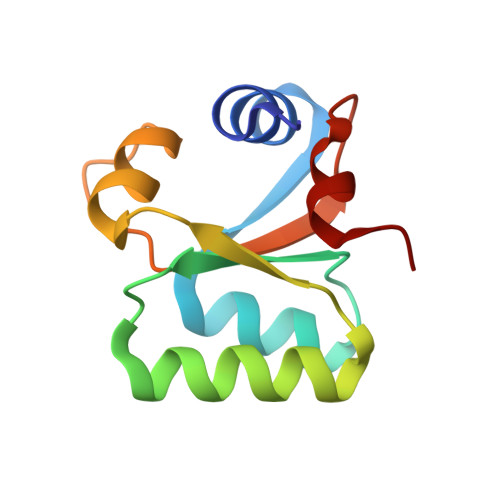Stabilizing salt-bridge enhances protein thermostability by reducing the heat capacity change of unfolding.
Chan, C.H., Yu, T.H., Wong, K.B.(2011) PLoS One 6: e21624-e21624
- PubMed: 21720566
- DOI: https://doi.org/10.1371/journal.pone.0021624
- Primary Citation of Related Structures:
3LFO, 3RA5, 3RA6 - PubMed Abstract:
Most thermophilic proteins tend to have more salt bridges, and achieve higher thermostability by up-shifting and broadening their protein stability curves. While the stabilizing effect of salt-bridge has been extensively studied, experimental data on how salt-bridge influences protein stability curves are scarce. Here, we used double mutant cycles to determine the temperature-dependency of the pair-wise interaction energy and the contribution of salt-bridges to ΔC(p) in a thermophilic ribosomal protein L30e. Our results showed that the pair-wise interaction energies for the salt-bridges E6/R92 and E62/K46 were stabilizing and insensitive to temperature changes from 298 to 348 K. On the other hand, the pair-wise interaction energies between the control long-range ion-pair of E90/R92 were negligible. The ΔC(p) of all single and double mutants were determined by Gibbs-Helmholtz and Kirchhoff analyses. We showed that the two stabilizing salt-bridges contributed to a reduction of ΔC(p) by 0.8-1.0 kJ mol⁻¹ K⁻¹. Taken together, our results suggest that the extra salt-bridges found in thermophilic proteins enhance the thermostability of proteins by reducing ΔC(p), leading to the up-shifting and broadening of the protein stability curves.
- School of Life Sciences, Centre for Protein Science and Crystallography, The Chinese University of Hong Kong, Hong Kong, Shatin, Hong Kong SAR, China.
Organizational Affiliation:
















